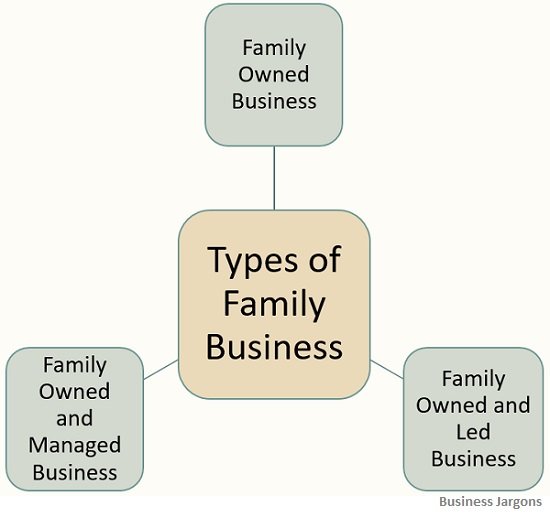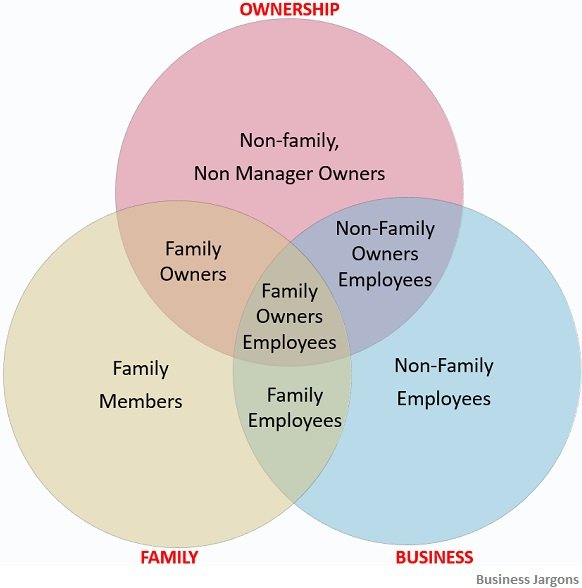Definition: Family business, as the name suggests, is the business which is actively owned, operated and managed by two or more members of the single-family. Here, members may be related by blood, marriage or adoption. Basically, in a family business:
- Single-family owns majority percentage of ownership
- Possess voting control,
- Has power over strategic decisions,
- Has the involvement of multiple generations of the same family and
- Senior management of the firm is drawn from the same family.
Family Business plays a significant role in the economy. Indeed it is the oldest surviving economic system, that has a substantial contribution in the country’s Gross National Product (GNP), total employment and total exports.
Examples
Here are some successful and popular examples of family business organization from across the world:
| Company | Country | Industry | Family Name |
|---|---|---|---|
| Walmart | USA | Retail | Walton |
| Berkshire Hathaway | USA | Conglomerate | Buffet |
| Hyundai | South Korea | Automotive | Chung |
| Samsung Group | South Korea | Conglomerate | Lee |
| BMW Group | Germany | Automotive | Quandt |
| Ford | USA | Automotive | Ford |
| Toyota Group | Japan | Automotive | Toyota |
| Reliance Industries | India | Conglomerate | Ambani |
| LG | South Korea | Consumer Electronics | Koo |
| Dell Technologies | USA | Computer Hardware | Dell |
| Tata Group | India | Conglomerate | Tata |
Characteristics of Family Business
A family business is characterized by:
- Members: A group of people, who are the members of the same family owns and runs the business enterprise.
- Position of members: The position of family members in the business depends on the relationship which the family members have with one another.
- Control: As the family owns a majority share in the company and also constitutes the senior management, it can exercise control over the business.
- Mutual interest: As the family members occupy the key positions in the business, it can exercise influence on the policies of the firm, as per the mutual interest of the family and firm.
- Involvement of multiple generations: The operation and management of the business are looked after by the family, and so the reins are passed on, from one generation to another.
- Mutual Trust: All the members of the family have mutual trust in each other, as they have a common origin, the same set of values, ethics and business orientation.
- Integrity and Transparency: It is generally characterised by strong moral principles and honesty towards business goals and business transparency.
Types of Family Business
In general, there are three forms of the family business, which are discussed hereunder:
- Family Owned Business: As the name suggests, a family-owned business in one in which the controlling size of the ownership stake is owned by the family or by the member of the family.
- Family Owned and Managed Business: In this kind of businesses the controlling size of ownership, lies in the hands of a single-family, or by a single member of a family. The controlling ownership allows the family to formulate and decide the objectives, methods and policies.
- Family Owned and Led Business: In such a business, along with the ownership of majority stake by the family or by the member of the family, at least one member of the family is a member of the board of directors. In this way, the family member can exert influence over business’s direction, strategies and plans.
Who are First Generation Entrepreneurs?
These are New Entrepreneurs, who invest their money and bears risks and uncertainties to set up the business. They are wealth creators and pioneers in the business. They are innovators who bring new ideas to the business.
Who are Second Generation Entrepreneurs?
Second Generation Entrepreneurs are supposed to control and run the business established by their parents, but their activities and decisions are always under examination. They join the business as middle or top-level management, and after showcasing their potential, the reins of the business are handed over to them.
Structure of Family Business
The three-circle model of the family business system is represented as under:

In this model, the first circle indicates ‘ownership’, the second circle represents ‘family’ while the third represents ‘business’. Now we will discuss entity in detail:
- Non-family non-manager owners: These are an external investor or say outsiders, who own a certain proportion of business but do not work.
- Family owners: This group include those family members who own a part of the business but do not take part in its operations.
- Family owner-employees: As the name specifies, these are the owners of the business, as well as work as an employee in the firm, usually in top managerial positions.
- Non-family owners employees: This group covers those individuals who are employees of the concern and are not family members, as well as own a certain proportion of the firm’s share capital.
- Family members: This group includes all those family members who neither own shares in the company nor they are actively involved in the family business.
- Family Employees: In this group, all those members of the family are covered who work for the company, but they do not own part of the company’s share capital.
- Non-family employees: These are the employees of the company, who work for the company under an employment contract, and are not family members. They also don’t own shares in the company.
The Bottom Line
By sum and substance, initially, when the business is set up, it is like an ordinary business, but over the years other generations of the founder’s family and their extended families, start taking part in the business, which makes it a family business. And the key managerial positions of the concern are absorbed by the family members.

Dr. Saleh Alkhatib says
Thank you,
Well done and Well organized, helped me so much to prepare a quick presentation about family owned business.
Regards